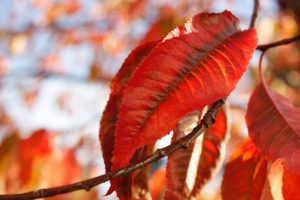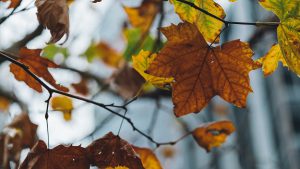
Several years ago in late September I had a visit to one of the fern nursery in Volusia County. I was impressed with their shipping operation where fern leaves, baby’s breath and an assortment of other decorative items for the floral trade were being packaged and prepared for shipment to grocery store florists. One element I did not expect was a machine that spray painted the leaves of the red oak to look like fall foliage. Small oak branches full of green leaves were attached to a conveyor line which circulated them through a spray series of red, yellow and orange paint with a finishing shellac coating. When they emerged they looked like fall foliage from Maine or Vermont. I would never have thought this foliage, shipped throughout the country, would have emanated from Florida.
On a more recent note I received an email a few years back in October wondering when the peak of the fall foliage season occurred in Ocala. It was a question I had never really given much thought to – I didn’t know we had a fall foliage season in Ocala. My initial reaction was to write back and ask where they were from – the Equator? But it made me think about sources of color in this area of the world. Usually it isn’t fall foliage – more like a slight color change in early winter, around New Years.
Over my years in Marion County I have observed a fall or winter color change on a few plants and if one desires fall color there are a couple choices that will give potential for a color change, although not every year. The extent of color seems to be related to weather conditions, particularly mid – late November cold snaps. If you think you want to plant for some coloring as plants enter dormancy, here are some to try.
Trees for Fall Color
A first of these is the maple tree, which is more traditionally a northern tree. There are however two that will perform in Florida’s conditions – the Red Maple and the Florida Maple. Of these the Red Maple is probably the most likely to give nice, showy color in late December, though it cannot be depended on for this every year. A couple of maple trees that do not perform well in Florida are the Silver Maple and the most common maple in the eastern United States, the Sugar Maple. Several years ago I had two Red Maples inside my front entry gate. One year in late December these colored beautifully and had a striking orange color for three or four days after which a hard overnight rain event removed nearly all of the leaves.
One common plant that thrives in Ocala is the Crape Myrtle. In certain years I have observed fantastic red color in late fall, particularly in the Natchez variety. Crape myrtles are easy to grow and certain varieties will provide some shade while remaining an acceptable size for city lots. During late spring and summer they offer colorful blooms in a variety of colors Their leaves are small and rarely would require raking for removal. Their potential for fall color may add something to the many other attributes they offer.
Colorful Oaks

Of the oaks available for successful growth in Marion County, the shumard offers the greatest potential for some seasonal color. Typically red, I have also observed a tinge of orange some years in this tree. Coloration again appears to be weather related and as weather conditions vary widely from year to year, so also does the range of colors, with some years offering nothing at all or merely a dull brown color. These leaves are large and probably will need to be raked. In my own yard I have found them to be an excellent source of cover for winter and spring plant beds as well as for the vegetable garden.
Another oak that offers a tinge of red both in spring and in the fall is the Nuttall Oak. This is among the latest trees to leaf out in the spring, usually into April. As the early leaves emerge, the tree exhibits red color and does so again in early winter, when it loses its leaves.
Fall color, as we think of it in northern climates, is not nearly so prevalent in Marion County as it is in states above the Mason-Dixon line, yet there is ever so slight a change, with some years exhibiting greater color than others. Choose and locate plants in your yard carefully for the occasional display of late season color.
 0
0
